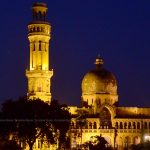The Sad Part of The Masterpieces
Buildings of Husainabad and its preservation
It is a matter of concern, wrote several historians, that the Nawabs, their family members and also the richer forebears of each community built very large and spacious buildings in Lucknow and they did not make any provision for its maintenance or preservation. But documentary evidences are available to prove that every monument had some source of income for its maintenance, either attached property or cash, which was to be used for maintenance of these monuments.
Mirza Abu Talib Londoni stated that Asif-ud-Daula spent Rs. Five lakhs on maintenance and conservation of Imambara every year on the occasion of Muharram. His travelogue covering his impression of England and Europe, with the name Maseer-e-Talibi also discovered that Asif-ud-Daula spent Rupees five lakhs on the occasion of Muharram. Shustri says that Asif-ud-Daula spent Rs. three lakhs on the first ten days of Muharram. According to Martin’s letters Martin had also, in his role as money-lender, lent sums to the Nawab for its maintenance etc., which had always previously been repaid by the Nawab’s Amils, including Ilmas Ali Khan but the letters of Claud Martin to Nawab Wazir- Asif- ud-Daula dated 8th July 1796, and 9th September 1795, showed that the Nawab was indebted to Claud Martin for a tune of Rupees three to four lakhs, which he has been repeatedly asking for repayment. On the contrary, Martin, at the death of Nawab Wazir – Asif-ud-Daula, has shown the rarest of the rare sentiment in his letter to M/s William and Thomas Raikas and Company on 23rd September 1797, just after two days of the death of Nawab Wazir.

It was on September 21st 1797 that he breathed his last. He was succeeded by a young man of about 17 years old, which give us the idea that the Company would have became the tutor and manager of the affairs of Government, and in the end perhaps the proprietor. This even can be utilized to throw some light on the fact that as the father has left a large treasure; the young vizier was made to lend a large portion of it to (the) Company.
On March 1st 1798, Martin wrote – “There could have been a great change in this Court, our Government could have acquired millions in terms of loan and could have influenced him for the proper management of his country, by the time late vizier (Asif-ud-Daula) died, and his sons (Wazir Ali) succeeds to the Nawabship, which could have been possible, only if acted upon properly and been conducted from a tender age, by the Company to manage the whole country as tutor. This could have been the mean to manage the whole country, as there existed a treasure of several crore of rupees in cash and jewels, which could have been deposited in government’s hands till the time he (Wazir Ali) acquires a proper age and is fit to manage his own country.
In course of time, the boy fell in the hands of bad advisors, plundered his father’s treasure and distributed money among the soldiers….”
The statement in the letters of Claud Martin make it very clear that the Nawab Wazir-Asif-ud-Daula had crore of rupees in cash and jewels in addition, and that he spent lakhs of rupees every year for conservation of the buildings, which makes it clear that this can not be true that he was indebted.
The rulers of Oudh in succession advanced loans to or placed deposits with the East India Company. The interest occurring at the rate of 4-5 percent per annum was earmarked for certain specific charitable purposes. This amount was directly remitted to the beneficiaries and spent on the specified purposes by the resident himself, who was accountable to none. A number of deeds of such deposits and loan have survived to show who the beneficiaries actually were.
Bahu Begum in her treaty with East India Company specified Rs. 18,000/- Sikka for the maintenance of the road in front of Imambara. In the words of John Pemble – “It was the treaty of 1825 that gave rise to the most notorious case of interposition by the Resident between the monarch and one of his subjects. By lending a crore of rupees to the Company in return for a guarantee that a stipulated portion of the interest would be paid”… Thus during the period 1814-42 contributions totaling not less than 48 million rupees had been lent by the kings of Oudh to British East India Company” for maintenance of buildings and pension to their relatives.
Ghazi-ud-din Haider perpetuated a loan of Rs. 1,08,50,000 (one crore eight lakh and fifty thousand @ 6% per annum on 14th November 1814. The annual interest of loan of Rs. 6,51,000 had to be invested for payment of his relations and servants and also for maintenance of the buildings erected by him. This deed ratified again on 11th May 1816 and Rs. 1,137-10-8 has been year marked for Imambara Shah Najaf.

King Mohammad Ali Shah constructed Imambara Husainabad, which was previously known as Imambara Hasan Raza Khan at Jamuniabagh. It was on On 23rd November 1839, that king Mohammad Ali Shah executed a trust deed no. LXVII at the rate of 4% per annum, by which he deposited the sum of rupees 12 lakhs in perpetuity in the Hon’ble Company’s treasury at the Residency of Lucknow and the interest amounting to forty eight thousand Lucknow sikka rupees per annum has been bestowed as a gift upon the persons herein mentioned and for the expenses of Husainabad Mubarak and Company.
“Rafiq-ud-Daula was the first caretaker of Imambara Husainabad. It was looted in 1857 and auctioned; Jagat Seth purchased it in Rs. 16,000/-. It was the system of the Nawab Wazirs of Oudh to make necessary provisions for maintenance and preservation of the monuments erected by themselves. As per Article 1 of deed XLV Rafiq-u- Daula, Syed Imam Ali Khan and Azeem-ulla Khan were appointed caretakers against the deed of Rs. 12,00,000/- deposition @ 4% interest per annum. Rs. 48,000 of which reserved for the maintenance of Roads etc. of the Husainābad Mubarak.
Article (4) reads, as the whole of the income and disbursements of Husainabad Mubarak and the new road and their dependencies have been placed entirely at the disposal of Rafiq-ud-Daula, Syed Imam Ali Khan and Azeem-ulla Khan Bahadur without the participation of Sharaf-ud-Daula Bahadur, it is necessary that they should receive with honesty, the sums set apart for Husainabad Mubarak and other incomes of it and its dependencies, and expand them with all probity and economy and carefully preserve the whole of the property in Husainabad Mubarak so that to the upmost of their power it may not be lost or spoiled.
For his other building Shahi Shifakhana (the Government Hospital), Mohammad Ali Shah executed another deed No. XLVI with Company Bahadur on 26th January 1840 and deposited Rs. 3,40,800/- Calcutta Sikka rupees @ 4% interest, amounting to Rs. 16,632 Calcutta Sikka rupees equivalent to Rs. 17,244-9-6 (Rupees-Aanas-paisa) Lucknow Sikka rupees reserved to its conservation.
King Wajid Ali Shah, before ascending the throne, passed orders for the construction of his father’s Mausoleum at a cost of about ten lakhs of rupees. It is however, significant that though King Wajid Ali Shah ruled for another five years (after Resident’s report of 1851), he neither asked for a loan from any private banker or from the British Government to pay off any arrears, nor did he leave after his deposition any large arrears or debt. On the other hand, he invested Rs. 20,50,000 (Rupees twenty lakh fifty thousand) in the government promissory notes to stand in the name of different persons, together with seven lakhs of rupees invested with the British Government in the form of a perpetual loan for the expenses of the late king Amjad Ali Shah’s Mausoleum.
A Farman of Wajid Ali Shah is also available with a Nawab of Lucknow specifying the land of Bibiapur for maintenance and preservation of the white Baradari of Qaiserbagh, which is actually the Imambara of Wajid Ali Shah and known as Qasr-ul-buka. This Farman of Wajid Ali Shah appointed a man named Chait Ram as caretaker of this Imambara. But after the recapture of the city, British divided Qaiserbagh into two portions and a run through road laid there. The first war of independence has been fought in 1857 on this soil for the largest duration, in which Indians could not get success and after the British rule, there were strict restrictions for any attendance or appearance of Lucknow citizenry to these buildings particularly from Qaiserbagh to new cantt area. A number of Imambara, palaces, and gardens were denied any work of preservation. The whole of the city was declared as nuzool (govt. property) land and the Indians were not allowed any kind of restoration. Since, the main source of repairing maintenance and conservation of these monuments has been the government source, and in absence of any patronage from them the monuments have been opened and lying barren for all kinds of menace.
Baoli
To the east of the main building of Imambara exists Baoli, originally a five- storey building constructed out of which only two storeys can be seen. The middle floor ceiling has collapsed and the structure under water can collapse anytime. It has been a part of famous Panch Mahala of Shuja-ud-daula. The level of water in ‘Baoli’ is connected to the river Gomti, a myth people generally believe, which is not true. It is the rainwater collected here for being the lowest point of the area. It is, therefore, very much advisable that the water must be bailed out from the Baoli for the proper preservation of the remaining portion of Panch Mahala. Provisions should also be made to avoid any kind of rainwater or drain water sneaking into the structure.
There are a number of stories about the Baoli. Out of which one says it was a big well, and the other one say it was Shahi Baoli or Royal Bathing place. This was not, however, the generally accepted view and one of the first accounts of the area has been written before 1785. The eastern gateway of the Imambara complex was said to be the gate of Panch Mahala, which is now gate of Baoli too. The second Courtyard consisted of the state apartments ‘encompassing a square garden, together with an external enclosure for smaller rooms… called Baoli from the large well within it, which includes a staircase and smaller recesses, with openings in the well from top to bottom.
The present Govt. Husainābad Inter College is situated on the mound, which was created when the Machchi Bhawan was bombarded and Panch Mahala got demolished. The heap of debris settled on the destructed building and a permanent mound got established. There still exists on the north side of slope on the premises of the Husainabad College the slab of a hall, which was caved in after the bombardment.
In late 1960s for the first time a crane has been used to clear the waste dumped into the Baoli by some thieves and vagabonds. This Baoli was probably the actual Panch Mahala as it is evident from the photograph of its gate. Despite having hundreds of thousands of rupees, the Husainabad and Allied Trusts has least interest in its preservation.
Dr. Roshan Taqui
Writer is Lucknow based historian.
(Published in The Lucknow Observer, Volume 1 Issue 12, Dated 05 March 2015)




